- Home
- About
- Map
- Trips
- Bringing Boat West
- Migration West
- Solo Motorcycle Ride
- Final Family XC Trip
- Colorado Rockies
- Graduates' XC Trip
- Yosemite & Nevada
- Colorado & Utah
- Best of Utah
- Southern Loop
- Pacific Northwest
- Northern Loop
- Los Angeles to NYC
- East Coast Trips
- Martha's Vineyard
- 1 Week in Quebec
- Southeast Coast
- NH Backpacking
- Martha's Vineyard
- Canadian Maritimes
- Ocracoke Island
- Edisto Island
- First Landing '02
- Hunting Island '02
- Stowe in Winter
- Hunting Island '01
- Lake Placid
- Chesapeake
- Provincetown
- Hunting Island '00
- Acadia in Winter
- Boston Suburbs
- Niagara Falls
- First Landing '99
- Cape Hatteras
- West Coast Trips
- Burning Man
- Utah Off-Roading
- Maui
- Mojave 4WD Course
- Colorado River Rafting
- Bishop & Death Valley
- Kauai
- Yosemite Fall
- Utah Off-Road
- Lost Coast
- Yosemite Valley
- Arizona and New Mexico
- Pescadero & Capitola
- Bishop & Death Valley
- San Diego, Anza Borrego, Joshua Tree
- Carmel
- Death Valley in Fall
- Yosemite in the Fall
- Pacific Northwest
- Utah Off-Roading
- Southern CA Deserts
- Yosemite & Covid
- Lake Powell Covid
- Eastern Sierra & Covid
- Bishop & Death Valley
- Central & SE Oregon
- Mojave Road
- Eastern Sierra
- Trinity Alps
- Tuolumne Meadows
- Lake Powell Boating
- Eastern Sierra
- Yosemite Winter
- Hawaii
- 4WD Eastern Sierra
- 4WD Death Valley +
- Southern CA Deserts
- Christmas in Tahoe
- Yosemite & Pinnacles
- Totality
- Yosemite & Sierra
- Yosemite Christmas
- Yosemite, San Diego
- Yosemite & North CA
- Seattle to Sierra
- Southwest Deserts
- Yosemite & Sierra
- Pacific Northwest
- Yosemite & South CA
- Pacific Northwest
- Northern California
- Southern Alaska
- Vancouver Island
- International Trips
- Index
- Tips
- Books
- Photos/Videos
- Search
- Contact
Skaftafell - Svartifoss and Skaftafellsjökull, Iceland
Friday, June 2, 2023 - 4:45pm by Lolo
50 miles and 1 hour from our last stop - 1 night stay
Travelogue
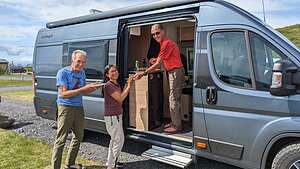 Herb's PylsursAfter leaving Fjaðrárgljúfur Canyon, we drove for about another hour to Skaftafell, where we planned to spend the night.
Herb's PylsursAfter leaving Fjaðrárgljúfur Canyon, we drove for about another hour to Skaftafell, where we planned to spend the night.
Skaftafell was once its own National Park, but in 2008 it became part of the larger Vatnajökull National Park. Vatnajökull has a lot of superlatives associated with it: not only is it one of the largest national parks in Europe, but its ice cap (also called Vatnajökull) is the largest ice cap in Europe. It is so large that if covers 11% of the surface area of Iceland - or at least it did before global warming began melting most of the world’s ice caps.
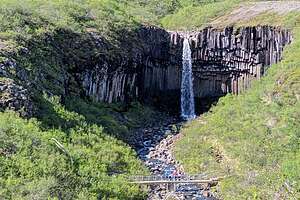 Heart-shaped SvartifossVatnajökull National Park has several entry points, but Skaftafell is the best place to explore the park from the southern side.
Heart-shaped SvartifossVatnajökull National Park has several entry points, but Skaftafell is the best place to explore the park from the southern side.
We didn’t know it yet, but the Skaftafell campground would be the nicest one we would stay in during the entire trip. Most of the campgrounds in Iceland are basically grassy areas that you park on with a range of facilities. All have bathrooms and most have showers, but usually not enough for the amount of people camping there.
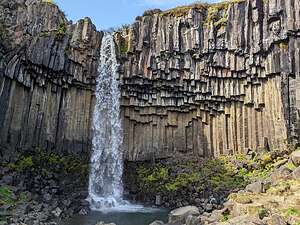 SvartifossThis one was in a lovely setting with a gravel area to park in surrounded by a grassy area to sit out in. It also had great facilities (lots of bathrooms and showers, laundry, etc.). However, even more importantly, it was located near the trailhead for the two hikes we planned to do today: Svartifoss (waterfall) and Skaftafellsjökull (glacier), so we didn’t have to move the campers.
SvartifossThis one was in a lovely setting with a gravel area to park in surrounded by a grassy area to sit out in. It also had great facilities (lots of bathrooms and showers, laundry, etc.). However, even more importantly, it was located near the trailhead for the two hikes we planned to do today: Svartifoss (waterfall) and Skaftafellsjökull (glacier), so we didn’t have to move the campers.
Since this was going to be our base camp for the day’s activities, we got there right around lunchtime. We were not particularly creative with our menu when cooking in the van, mostly because we ate out whenever possible.
 Svartifoss close-upHowever, we did find that Herb’s bratwurst (sort of a German Pylsur) and Hilda’s salads were easy and tasty. So that’s what we did.
Svartifoss close-upHowever, we did find that Herb’s bratwurst (sort of a German Pylsur) and Hilda’s salads were easy and tasty. So that’s what we did.
This was the first day that it was actually warm enough to sit outside in shorts and a t-shirt, definitely not the Iceland we expected. We were very, very lucky with the weather - the forecast had 10 days of sunshine and fairly warm (for Iceland) temperatures in the upper 50s and lower 60s - definitely much better than the cold, rainy weather more typical this time of the year.
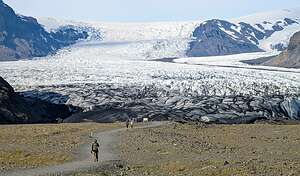 Approaching SkaftafellsjökullAfter lunch and a brief siesta, we set out on a 3-mile hike to Svartifoss, which is Icelandic for “Black Waterfall,” because of its beautiful backdrop of black hexagonal basalt columns.
Approaching SkaftafellsjökullAfter lunch and a brief siesta, we set out on a 3-mile hike to Svartifoss, which is Icelandic for “Black Waterfall,” because of its beautiful backdrop of black hexagonal basalt columns.
The water originates from the Svinafellsjokull glacier, also in Vatnajökull National Park, and plunges 80 feet over a cliff into a heart-shaped amphitheater surrounded by tall black basalt columns. These columns were created by lava rapidly cooling and contracting over centuries, typically splitting into six-sided columns.
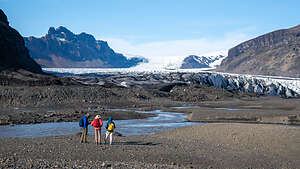 SkaftafellsjökullIf you look really close, you can see that the rock faces are marked by narrow horizontal bands. This is due to slow fracturing events as the columns cascade downwards. Bit by bit, the basalt crystals break off and plunge into the river at the base of the falls.
SkaftafellsjökullIf you look really close, you can see that the rock faces are marked by narrow horizontal bands. This is due to slow fracturing events as the columns cascade downwards. Bit by bit, the basalt crystals break off and plunge into the river at the base of the falls.
Although not necessarily one of the tallest waterfalls we would see, it certainly is one of the most picturesque, and served as the inspiration for architect Guðjón Samúelsson’s design of Reykjavik’s Hallgrímskirkja, the largest church in Iceland.
After Svartifoss we hiked another 3.5-miles to Skaftafellsjökull, a glacier tongue spurting off from Iceland's largest ice cap, Vatnajökull. Just like “foss” means waterfall in Icelandic, “jökull” means glacier. I had now doubled my Icelandic vocabulary
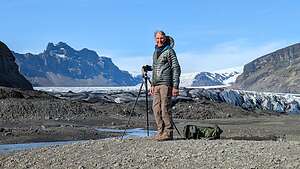 Happy HerbIt was massive, despite the fact that over the last decade, Skaftafellsjökull has been receding dramatically, serving as another example of how climate change is steadily affecting the glaciers in Iceland and how stronger environmental policies are needed asap to preserve the world’s glaciers.
Happy HerbIt was massive, despite the fact that over the last decade, Skaftafellsjökull has been receding dramatically, serving as another example of how climate change is steadily affecting the glaciers in Iceland and how stronger environmental policies are needed asap to preserve the world’s glaciers.
Foolishly we thought we would be able to walk on the glacier, not realizing that there would be so much water between our trail and it, because of the great amount of melting occurring. So, we satisfied ourselves by admiring it from afar.
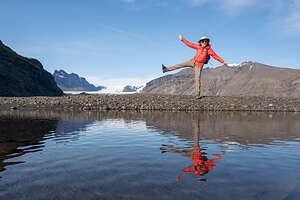 Happy LoloI became curious as to why the edge of the tongue was so black and dirty looking, so when I got home I tried to find out why.
Happy LoloI became curious as to why the edge of the tongue was so black and dirty looking, so when I got home I tried to find out why.
What I discovered is that a substance called Cryoconite, which is a powdery windblown dust made of a combination of small rock particles, soot and bacteria, gets trapped in holes in the glacier’s surface.
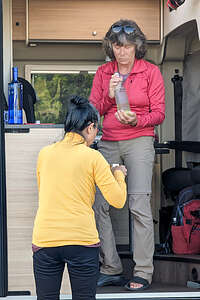 My wine barWhile many of the materials in cryoconite are natural materials, human activities based on coal use have increased the amount of black soot in cryoconite since the substance was first discovered in 1870, causing glaciers to darken in a phenomenon scientists call “biological darkening.” Besides being aesthetically unpleasing, this darker surface absorbs rather than reflects heat from the sun’s rays, making snow and glaciers melt more quickly.
My wine barWhile many of the materials in cryoconite are natural materials, human activities based on coal use have increased the amount of black soot in cryoconite since the substance was first discovered in 1870, causing glaciers to darken in a phenomenon scientists call “biological darkening.” Besides being aesthetically unpleasing, this darker surface absorbs rather than reflects heat from the sun’s rays, making snow and glaciers melt more quickly.
Skaftafellsjökull was still an overwhelmingly impressive sight to see, so we figured we should enjoy it while we still could. I only hope that it will still be around for my grandchildren (who don’t exist yet) to enjoy in their lifetime.
What an incredible variety of experiences in two short hikes!
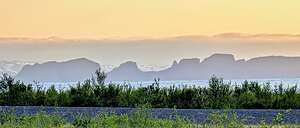 View from our camper at 10 pmWhen we got back to our campsite, it was still a lovely evening, a bit cooler, but still warm enough to sit outside for cocktail hour.
View from our camper at 10 pmWhen we got back to our campsite, it was still a lovely evening, a bit cooler, but still warm enough to sit outside for cocktail hour.
Later on, after everyone had gone to bed, I walked outside our camper and was treated to a splendid display of colors - snow-covered mountains squeezed between blues and the golden light of pre-sunset. It was 10:00 pm, but there was still plenty of light in the land of the Midnight Sun.
- ‹ previous
- 7 of 30
- next ›
Skaftafell - Svartifoss and Skaftafellsjökull location map in "high definition"
Javascript is required to view this map.
